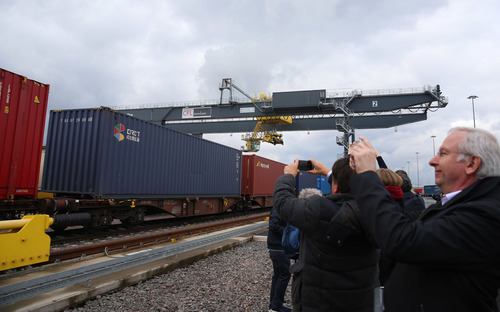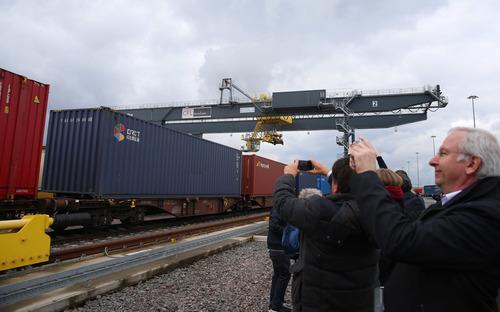
Guests record the start of the first Luxembourg-Chengdu freight train at a cargo train station in Dudelange, Luxembourg, April 4, 2019. (Xinhua/Zheng Huansong)
The Belt and Road Initiative (BRI) is a way for win-win cooperation that promotes common development and prosperity and a road towards peace and friendship by enhancing mutual understanding and trust, and strengthening all-round exchanges. The Chinese government advocates peace and cooperation, openness and inclusiveness, mutual learning and mutual benefit. It promotes practical cooperation in all fields, and works to build a community of shared interests, destiny and responsibility featuring mutual political trust, economic integration and cultural inclusiveness.

Picture shows the Silk Road Economic Belt and the 21st Century Maritime Silk Road, collectively known as the Belt and Road initiative. (Xinhua)
The Belt and Road run through the continents of Asia, Europe and Africa, connecting the vibrant East Asia economic circle at one end and developed European economic circle at the other, and encompassing countries with huge potential for economic development. The Silk Road Economic Belt focuses on bringing together China, Central Asia, Russia and Europe (the Baltic); linking China with the Persian Gulf and the Mediterranean Sea through Central Asia and West Asia; and connecting China with Southeast Asia, South Asia and the Indian Ocean. The 21st-Century Maritime Silk Road is designed to go from China's coast to Europe through the South China Sea and the Indian Ocean in one route, and from China's coast through the South China Sea to the South Pacific in the other.
On land, the Initiative will focus on jointly building a new Eurasian Land Bridge and developing China-Mongolia-Russia, China-Central Asia-West Asia and China-Indochina Peninsula economic corridors by taking advantage of international transport routes, relying on core cities along the Belt and Road and using key economic industrial parks as cooperation platforms. At sea, the Initiative will focus on jointly building smooth, secure and efficient transport routes connecting major sea ports along the Belt and Road. The China-Pakistan Economic Corridor and the Bangladesh-China-India-Myanmar Economic Corridor are closely related to the Belt and Road Initiative, and therefore require closer cooperation and greater progress.
The Initiative is an ambitious economic vision of the opening-up of and cooperation among the countries along the Belt and Road. Countries should work in concert and move towards the objectives of mutual benefit and common security. To be specific, they need to improve the region's infrastructure, and put in place a secure and efficient network of land, sea and air passages, lifting their connectivity to a higher level; further enhance trade and investment facilitation, establish a network of free trade areas that meet high standards, maintain closer economic ties, and deepen political trust; enhance cultural exchanges; encourage different civilizations to learn from each other and flourish together; and promote mutual understanding, peace and friendship among people of all countries.
One Belt One Road Map:1. North line A: North America (the United States, Canada) -- north Pacific –Japan -- South Korea -- the Sea of Japan -- Zarubino port – Huichun --Yanji –Jilin-- Changchun -- Mongolia – Russia -- Europe (northern Europe, central and eastern Europe, Western Europe, southern Europe)
2. North line B: Beijing -- Russia -- Germany -- northern Europe.
3. Middle line: Beijing -- Xi 'an -- Urumqi -- Afghanistan -- Kazakhstan -- Hungary -- Paris.
4. South line: Quanzhou – Fuzhou – Guangzhou – Haikou—Beihai -- Hanoi - Kuala Lumpur – Jakarta – Colombo – Kolkata -- Nairobi – Athens – Venice.
5. Central line: Lianyungang -- Zhengzhou -- Xi 'an -- Lanzhou -- Xinjiang -- central Asia -- Europe.




 A single purchase
A single purchase









